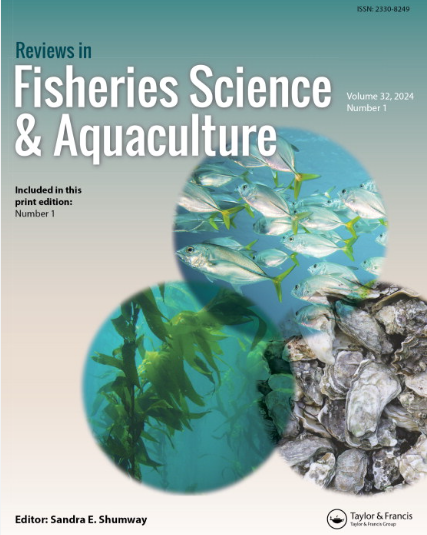Aquaculture: An Introductory Text – 4th Edition Robert R Stickney & Delbert M Gatlin III
IF 5.3
1区 农林科学
Q1 FISHERIES
引用次数: 4
Abstract
This is an unique book. As the title states, it is an introduction to aquaculture. It is not, however, the typical didactic text stuffed full of as many facts as the pages will hold. The book is laid out so a reader who is new to aquaculture can gain an understanding and appreciation of the farming of aquatic plants and animals around the world. The text contains a lot of information, but the boxes inserted within the text are the icing on the cake. The boxes contain simple explanations of different aspects of aquaculture and enjoyable anecdotes about people, organisms and phenomena. Many of the anecdotes are based on the authors’ personal experiences, of which there are many. Collectively, Stickney and Gatlin have over 100 years of experience contributing to and observing the development of the aquaculture industry. Like many texts, Chapter 1 serves to introduce the topic and define terms; however, Chapter 1 in this book serves two other purposes. First, it provides an eleven-page table that lists plants and animals that are cultured around the world. Just a casual review of the organisms listed gives a good sense of the diversity of aquaculture. Second, the authors acknowledge that aquaculture exploits natural resources. They then move into a discussion of sustainability, which has been a central point in aquaculture research and policy for the past few decades. To provide perspective, Stickney and Gatlin review sixteen criticisms of aquaculture made by various environmental groups. For each criticism, they provide a description of the criticism, the technical reality as it is known, and possible solutions. A careful reading of this section will impress upon people new to aquaculture that many criticisms are based more on socio-political views than technical failings of the culturist or culture system. Chapter 3 will probably be the most enjoyable chapter for the reader who is new to aquaculture. In it, the authors describe the kinds of culture systems used around the world. Ponds, raceways, recirculating systems, and cages are all covered in enough detail to give the reader a good sense of what they are and how they work. The text is supplemented with many pictures of production systems or components of production systems. Taken together, the text and pictures emphasize the diversity and scale of world aquaculture. One of the thorniest problems in aquaculture is the economical production of young animals to be grown to market size. Aquaculture animals are relatively small (a few dozen grams for a shrimp to a few kilograms for a salmon) when marketed compared to most farm animals. Hence, having efficient methods of producing large numbers of stockers is critical. Reproduction of tilapia, catfish and carps is relatively easy; however, many of the marine fishes and crustaceans are difficult to reproduce economically, representing a serious constraint to commercial production. Chapter 6 addresses reproduction in a way that is easy to follow and gives the reader an appreciation of the complexity of producing stocker animals for some species. Along with describing how to reproduce selected species, the authors also describe old and new techniques such as sex reversal, polyploidy, hybridization, gynogenesis, selective breeding, and genetic engineering. Chapter 8 presents a good overview of preparing and delivering feeds. Once again, this is a good chapter for someone new to aquaculture. Early in the chapter, the authors describe traditional fish and shrimp diets that contained a great deal of fish meal as a protein source. They then talk about the need to move away from fish meal as much as possible due to world-wide shortages. Indeed, this may be the key problem to solve if the production of carnivorous fishes and crustaceans is to continue to grow. The scale of the efforts to replace fish meal is demonstrated in a two column box describing alternative protein feedstuffs. The chapter also describes the technology involved in producing, and delivering the massive quantities of feed to fish culture systems. Someone new to aquaculture who reads this book may come away from the experience thinking that the development of modern aquaculture (defined here as development in the 20th and 21st centuries) was a hit-and-miss venture. In many aspects, it was; however, somehow it worked. Prior to 1970, aquaculture provided about 1% of world seafood supplies. Now, it arguably provides half of seafood supplies. In the space of fifty years, we have witnessed the change from almost exclusively hunting and gathering seafood to farming a big part of it – a trend that is bound to continue. Stickney and Gatlin’s 4th edition of Aquaculture: An Introductory Text will give the reader a good sense of how it was done and what the future holds.水产养殖:介绍性文本-第4版罗伯特R斯蒂克尼和德尔伯特M加特林III
这是一本独一无二的书。正如标题所述,这是一本水产养殖入门书。然而,它并不是那种典型的说教式文本,里面塞满了大量的事实。这本书是为了让一个对水产养殖不熟悉的读者能够了解和欣赏世界各地的水生植物和动物养殖。文本包含了很多信息,但插入文本中的框是锦上添花。盒子里有关于水产养殖不同方面的简单解释,以及关于人、生物和现象的有趣轶事。许多轶事都是基于作者的个人经历,其中有很多。斯蒂克尼和加特林在促进和观察水产养殖业发展方面总共有100多年的经验。与许多文本一样,第一章主要介绍主题和定义术语;然而,本书的第一章还有另外两个目的。首先,它提供了一个11页的表格,列出了世界各地培育的动植物。只要随便回顾一下所列出的生物,就能很好地了解水产养殖的多样性。其次,作者承认水产养殖会消耗自然资源。然后他们开始讨论可持续性,这是过去几十年水产养殖研究和政策的中心问题。为了提供观点,斯蒂克尼和加特林回顾了各种环境组织对水产养殖的16项批评。对于每个批评,他们提供了对批评的描述,已知的技术现实,以及可能的解决方案。仔细阅读本节将给刚接触水产养殖的人留下深刻印象,即许多批评更多地是基于社会政治观点,而不是基于养殖者或养殖系统的技术缺陷。对于刚接触水产养殖的读者来说,第三章可能是最有趣的一章。在书中,作者描述了世界各地使用的各种文化系统。池塘、跑道、循环系统和笼子都有足够的细节,让读者很好地了解它们是什么以及它们是如何工作的。正文补充了许多生产系统或生产系统组成部分的图片。综合来看,文字和图片强调了世界水产养殖的多样性和规模。水产养殖中最棘手的问题之一是经济地生产幼龄动物,使其达到市场规模。与大多数农场动物相比,水产养殖动物在市场上相对较小(一只虾几十克,一条鲑鱼几公斤)。因此,拥有生产大量库存的有效方法是至关重要的。罗非鱼、鲶鱼和鲤鱼的繁殖相对容易;然而,许多海洋鱼类和甲壳类动物难以经济繁殖,严重制约了商业生产。第6章以一种易于理解的方式讨论繁殖问题,并使读者对某些物种的饲养动物的复杂性有了一个了解。除了描述如何繁殖选定的物种外,作者还描述了新旧技术,如性别逆转、多倍体、杂交、雌核发生、选择育种和基因工程。第8章很好地概述了准备和交付提要。对于刚接触水产养殖的人来说,这又是一个很好的篇章。在本章的开头,作者描述了传统的鱼虾饲料中含有大量的鱼粉作为蛋白质来源。然后他们谈到,由于全球范围内的鱼粉短缺,需要尽可能地远离鱼粉。事实上,如果食肉鱼类和甲壳类动物的产量继续增长,这可能是需要解决的关键问题。在描述替代蛋白质饲料的两栏框中展示了替代鱼粉的努力规模。本章还描述了生产和向鱼类养殖系统提供大量饲料所涉及的技术。一些刚接触水产养殖的人读了这本书后,可能会认为现代水产养殖的发展(这里定义为20世纪和21世纪的发展)是一次碰运气的冒险。在许多方面,它是;然而,不知何故,它成功了。1970年以前,水产养殖提供了大约1%的世界海产品供应。现在,可以说它提供了一半的海鲜供应。在50年的时间里,我们目睹了从几乎完全狩猎和采集海产品到养殖海产品的变化——这一趋势肯定会继续下去。斯蒂克尼和加特林的第4版《水产养殖:介绍性文本》将让读者很好地了解它是如何完成的以及未来会发生什么。
本文章由计算机程序翻译,如有差异,请以英文原文为准。
求助全文
约1分钟内获得全文
求助全文
来源期刊

Reviews in Fisheries Science & Aquaculture
FISHERIES-
CiteScore
25.20
自引率
0.90%
发文量
19
期刊介绍:
Reviews in Fisheries Science & Aquaculture provides an important forum for the publication of up-to-date reviews covering a broad range of subject areas including management, aquaculture, taxonomy, behavior, stock identification, genetics, nutrition, and physiology. Issues concerning finfish and aquatic invertebrates prized for their economic or recreational importance, their value as indicators of environmental health, or their natural beauty are addressed. An important resource that keeps you apprised of the latest changes in the field, each issue of Reviews in Fisheries Science & Aquaculture presents useful information to fisheries and aquaculture scientists in academia, state and federal natural resources agencies, and the private sector.
 求助内容:
求助内容: 应助结果提醒方式:
应助结果提醒方式:


